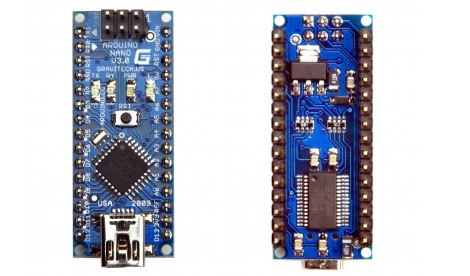The official Arduino Nano design has been updated to version 3.0. Like other new Arduino designs, it’s using the ATmega328 instead of the ATmega168. It’s also a slightly more reasonable $35. The small board is designed to be plugged directly into a breadboard and accessed via mini USB cable. This new design is also two layers instead of four making it easier to produce and modify. The new Nanos will ship at the end of the month.
Arduino Nano Updated
22 Comments
- by: Eliot
















nice.
Ordered.
I swear, Arduino is like the crack of the electronics world…cheap and highly addictive! :)
I’m getting one as soon as possible!
@pburgess
How can you say $35 is cheap when you could buy PDIP versions of the same chips for nearly 1/10th of the cost?
By all means, take as much crap, (oh, you said crack, my bad) you want…
Of note, I have nothing against the Arduino platform. It is awesome for rapid development and prototyping, but most folks stop there and call that good.
what is the poin of nano Arduino ? want a smaller size ? well it will newer be smaller than bare chip
There are so many projects that are temporary, maybe you just want to test a concept without rummaging through a parts bin or lengthy datasheet. The Arduino is perfect for this. And if $35 is within someone’s budget to not attempt a smaller/cheaper design, what’s wrong with that? It helps support the project :)
“Like other new Arduino designs, it’s using the ATmega328 instead of the ATmega168”
Blow up the picture of the ATmega :)
I bought one of these a couple months ago. Cheaper:
http://www.pjrc.com/teensy/
I’m really curious why no one is using the propeller for anything. Really. Sure, I assume spin sucks, but it works and the chip can run on C or assembly just as easy.
AWW CRAP! And I just bought a serial board and a Duemilanove!
Sucks, man. >:(
IIRC they were advertising the 1st nano with something like “It�s a four-layer board with power and ground planes to help provide ICs with sufficient charge during switching and reduce noise (EMC) on high speed switching I/O pins. Ground plane help reduce radiation (EMI). Power plane is low in inductance; therefore any transients that may develop on the power line will be at lower levels. ”
maybe the manufacturing costs were too high?
or the 4 layers board was not worth? ;)
Life2Death thanks for mentioning propeller, very interesting. I need to look into it more, see no mention of OSX/Mac development platform (still need to hit google).
I was wondering when they were going to do this. Now that it’s a 2 layer board, it’s as cheap as the Duemilanove. No, it’s not as small or as cheap as the ‘bare chip’, but the bare chip doesn’t have an a power regulator or usb. Hell, you can’t even interface the ‘bare chip’ to serial without a level shifter. So, add all that to your ‘bare chip’ and see which is smaller.
For me personally, I like the nano when space is a big concern (http://hackaday.com/2009/06/30/custom-car-door-keypad/) and the RBBB when you have a little more room.
from my experience and various sources, the avr chip from which the arduino gets *all* its technical features (in case you didn’t know) seems pretty resistant to electric noise (efficient on-chip decoupling) so a 4-layer board was pretty overkill.
Eh, $35 isn’t too bad, but you can still get the bare chips for $3 so I really don’t see the point. Sure, it’s easier, but c’mon, learning to do it the “real” way isn’t that much harder, and don’t we all want to get more skills?
I really suggest everyone look up how to program an AVR by itself. At its simplest you can borrow a friend’s programmer if avaliable, load a bootloader on it (also easy, just look it up) and then from then on you can load code via serial. It’s really not hard to start programming AVRs on the cheap. Also check out Sparkfun.com, they have some good tutorials.
-Taylor
@novice
haha your right, if you go look at the full size pic on the arduino website, the chip clearly says 168 instead of 328
@jamieriddles
isn’t that just an old pic of the old 4-layer nano?
The board claearly says V3.0. Also, the schematic at the website to pre order them has the V3.0 schematic with the 168 on it. What gives? All the pics at both site have the 168 chip.
They could have been working on the 3.0 board purely for cost reduction well before they decided to put the 328 chip in them. The two changes didn’t have to happen at the same time. The two chips are pin compatible after all. Perhaps they decided to go both at the same time for simplicity of sale, or to make an even stronger reason to buy it. I get twice the memory now for 15 dollars less?!? Sold!
hey arduino fans you will newer get ride of those tiny training wheals, newer
I appreciate dropping a Nano into a more complex PCB, abstracting away the uC to an open standard, easily swapping out uC “modules”, accessibility to a wide range of programmers, and one less thing to document and support!
.
It can help a proprietary PCB become less proprietary and more open.
.
A pick though. They missed providing a nice Eagle library for its footprint (Eagle libs for the Nano can be found elsewhere).
and where can we find it roger ?